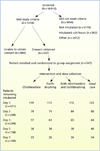Chlorhexidine, toothbrushing, and preventing ventilator-associated pneumonia in critically ill adults
- PMID: 19723863
- PMCID: PMC3722581
- DOI: 10.4037/ajcc2009792
Chlorhexidine, toothbrushing, and preventing ventilator-associated pneumonia in critically ill adults
Abstract
Background: Ventilator-associated pneumonia is associated with increased morbidity and mortality.
Objective: To examine the effects of mechanical (toothbrushing), pharmacological (topical oral chlorhexidine), and combination (toothbrushing plus chlorhexidine) oral care on the development of ventilator-associated pneumonia in critically ill patients receiving mechanical ventilation.
Methods: Critically ill adults in 3 intensive care units were enrolled within 24 hours of intubation in a randomized controlled clinical trial with a 2 x 2 factorial design. Patients with a clinical diagnosis of pneumonia at the time of intubation and edentulous patients were excluded. Patients (n = 547) were randomly assigned to 1 of 4 treatments: 0.12% solution chlorhexidine oral swab twice daily, toothbrushing thrice daily, both toothbrushing and chlorhexidine, or control (usual care). Ventilator-associated pneumonia was determined by using the Clinical Pulmonary Infection Score (CPIS).
Results: The 4 groups did not differ significantly in clinical characteristics. At day 3 analysis, 249 patients remained in the study. Among patients without pneumonia at baseline, pneumonia developed in 24% (CPIS >or=6) by day 3 in those treated with chlorhexidine. When data on all patients were analyzed together, mixed models analysis indicated no effect of either chlorhexidine (P = .29) or toothbrushing (P = .95). However, chlorhexidine significantly reduced the incidence of pneumonia on day 3 (CPIS >or=6) among patients who had CPIS <6 at baseline (P = .006). Toothbrushing had no effect on CPIS and did not enhance the effect of chlorhexidine.
Conclusions: Chlorhexidine, but not toothbrushing, reduced early ventilator-associated pneumonia in patients without pneumonia at baseline.
Comment in
-
Modest reduction in risk for ventilator-associated pneumonia in critically ill patients receiving mechanical ventilation following topical oral chlorhexidine.J Evid Based Dent Pract. 2012 Jun;12(2):103-6. doi: 10.1016/j.jebdp.2012.03.010. J Evid Based Dent Pract. 2012. PMID: 22726793 No abstract available.
-
Modest reduction in risk for ventilator-associated pneumonia in critically ill patients receiving mechanical ventilation following topical oral chlorhexidine.J Evid Based Dent Pract. 2012 Sep;12(3 Suppl):15-7. doi: 10.1016/S1532-3382(12)70004-0. J Evid Based Dent Pract. 2012. PMID: 23253825
Similar articles
-
Ventilator-associated pneumonia with or without toothbrushing: a randomized controlled trial.Eur J Clin Microbiol Infect Dis. 2012 Oct;31(10):2621-9. doi: 10.1007/s10096-012-1605-y. Epub 2012 Mar 16. Eur J Clin Microbiol Infect Dis. 2012. PMID: 22422274 Clinical Trial.
-
Modest reduction in risk for ventilator-associated pneumonia in critically ill patients receiving mechanical ventilation following topical oral chlorhexidine.J Evid Based Dent Pract. 2012 Sep;12(3 Suppl):15-7. doi: 10.1016/S1532-3382(12)70004-0. J Evid Based Dent Pract. 2012. PMID: 23253825
-
Oral mucosal decontamination with chlorhexidine for the prevention of ventilator-associated pneumonia in children - a randomized, controlled trial.Pediatr Crit Care Med. 2012 Sep;13(5):e305-10. doi: 10.1097/PCC.0b013e31824ea119. Pediatr Crit Care Med. 2012. PMID: 22760426 Clinical Trial.
-
Efficacy of toothbrushing procedures performed in intensive care units in reducing the risk of ventilator-associated pneumonia: A systematic review.J Periodontal Res. 2019 Dec;54(6):601-611. doi: 10.1111/jre.12668. Epub 2019 Jun 17. J Periodontal Res. 2019. PMID: 31206663
-
Oral hygiene with chlorhexidine in preventing pneumonia associated with mechanical ventilation.J Bras Pneumol. 2008 Sep;34(9):707-14. doi: 10.1590/s1806-37132008000900012. J Bras Pneumol. 2008. PMID: 18982209 Review. English, Portuguese.
Cited by
-
Electric versus manual tooth brushing among neuroscience ICU patients: is it safe?Neurocrit Care. 2011 Apr;14(2):281-6. doi: 10.1007/s12028-011-9502-2. Neurocrit Care. 2011. PMID: 21249529 Clinical Trial.
-
Intensive care nurses' opinions and practice for oral care of mechanically ventilated patients.Indian J Crit Care Med. 2013 Jan;17(1):23-7. doi: 10.4103/0972-5229.112154. Indian J Crit Care Med. 2013. PMID: 23833472 Free PMC article.
-
Impact of chlorhexidine mouthwash prophylaxis on probable ventilator-associated pneumonia in a surgical intensive care unit.Int J Crit Illn Inj Sci. 2016 Jan-Mar;6(1):3-8. doi: 10.4103/2229-5151.177368. Int J Crit Illn Inj Sci. 2016. PMID: 27051615 Free PMC article.
-
Complications and Pharmacologic Interventions of Invasive Positive Pressure Ventilation During Critical Illness.J Pharm Technol. 2018 Aug;34(4):153-170. doi: 10.1177/8755122518766594. Epub 2018 Mar 29. J Pharm Technol. 2018. PMID: 34860978 Free PMC article. Review.
-
Assessment of Nursing Staff's Knowledge, Attitude and Practice Regarding Oral Hygiene Care in Intensive Care Unit Patients: A Multicenter Cross-sectional Study.Indian J Crit Care Med. 2024 Jan;28(1):48-57. doi: 10.5005/jp-journals-10071-24601. Indian J Crit Care Med. 2024. PMID: 38510759 Free PMC article.
References
-
- Cook D. Ventilator associated pneumonia: perspectives on the burden of illness. Intensive Care Med. 2000;26(suppl 1):S31–S37. - PubMed
-
- Byers JF, Sole ML. Analysis of factors related to the development of ventilator-associated pneumonia: use of existing databases. Am J Crit Care. 2000;9:344–349. - PubMed
-
- Rodriguez JL, Gibbons KJ, Bitzer LG, Dechert RE, Steinberg SM, Flint LM. Pneumonia: incidence, risk factors, and outcome in injured patients. J Trauma. 1991;31:907–912. - PubMed
-
- Leu HS, Kaiser DL, Mori M, Woolson RF, Wenzel RP. Hospital-acquired pneumonia: attributable mortality and morbidity. Am J Epidemiol. 1989;129:1258–1267. - PubMed
-
- Haley RW, Schaberg DR, Crossley K, Von Allmen SD, McGowan JE., Jr Extra charges and prolongation of stay attributable to nosocomial infections: a prospective inter-hospital comparison. Am J Med. 1981;70:51–58. - PubMed


